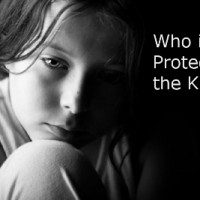Protecting the kids is everyone's job
- Details
- Published on Monday, 21 April 2014 09:47
- Written by Paul Gordon
The responsibility for ensuring the safety of children or ridding them of the horrors of abuse or neglect should extend beyond child welfare services, police agencies and juvenile courts.
Those in professions that cause them to be mandatory reporters of abuse and neglect or even suspicions of such should not be the only people that do so. Indeed, that responsibility lies with each of us who knows or suspects a child unable to defend himself or herself is being abused or neglected.
In a perfect world, anyway.
So say the people in those professions, those charged with watching out for the kids. April is Child Abuse Prevention Month but for these folks and countless others like them it is a year-round duty; indeed, for many a 24-7 proposition they believe strongly in.
Over the next four days The Peorian will look at the issue of child abuse and neglect and present stories about some of the agencies that charged with watching out for the kids, keep them safe and fed.
Some of what we learned may surprise you but for the most part it all comes down knowledge: That is, knowing when a child is in need of help and knowing what to do about it.
Progress has been made over the last two or three decades but much more needs to be done to protect the children, to break the cycles of violence that result from abuse, to get families in poverty the help they need.
It takes more than just those who are paid to do it or volunteer their time to such efforts.
"We recognize we cannot do it alone. I certainly believe we in Illinois are very committed to protecting our children, but we need everybody to be our eyes and ears," said Karen Hawkins, deputy director of communications for the Illinois Department of Children and Family Services.
DCFS, as it is most commonly known, has long been the agency charged with overseeing child welfare in Illinois. Founded 50 years ago, the agency also has had a host of critics through the years. That's because, Hawkins said, the public only hears about the cases that went wrong. "We're not perfect and don't claim to be. But statistics show we have had many, many successes and the number is growing," she said.
The agency is not about to rest on its laurels, however. "Much more can and will be done. But it starts with each individual. We need everybody in every neighborhood watching out for the kids. Some people believe it's none of their business to get involved, but we guarantee you the kids being abused or neglected want you to make it your business," Hawkins said.
Without those willing to step up, the situation would be far worse than it is. And it is bad enough, according to DCFS statistics.
The agency "receives, investigates and acts upon a report of child abuse or neglect every five minutes, child sex abuse every two hours, and the death of a child by abuse or neglect every day and a half," DCFS says on its website, www.state.il.us/dcfs.
It adds, "Tens of thousands of children are safer thanks to those who call our Child Abuse Hotline at 1-800-252-2873 each year. Unfortunately, up to 80 percent of abuse and neglect goes unreported, and one in five Illinois children is abused before the age of 18.
"There has been progress but it's still one of those things where people want to just cover their eyes and run away from it," said Clete Winkelmann, CEO of The Children's Home in Peoria. "Every day, it seems, I find myself in a situation where people don't want to hear about what I do for a living. It's too distressing. Yeah, tell me about it."
In the Greater Peoria area, there are more than 1,100 active cases of child abuse or neglect being investigated or adjudicated. Each of those cases requires a case worker from one agency or another, whether it be those employed by DCFS, The Children's Home or other child welfare agencies. DCFS oversees all private child welfare agencies in Illinois.
Some agencies go beyond abuse and neglect cases. For example, The Children's Home works with children who have mental health issues. The Center for Youth and Family Solutions is one of the agencies that gets involved with adoptions, including of abused or neglected children who cannot be returned to their birth parents. It also is central Illinois' top agency for dealing with runaways.
Most of these agencies have foster parents at the ready to take charge of the kids who have been removed from their homes. The need for foster care has diminished greatly in the last 15 to 20 years, from a high of more than 50,000 children in foster care in Illinois to less than 15,000 now.
Whether that spells success depends on perspective. The chief reason for the decline is a shift in philosophy. Children aren't removed from their home as quickly as they used to be; there must now be a real danger to the child before that happens. The goal became reunification of the family, keeping the unit together unless it is deemed impossible for the safety of the child.
This shift occurred largely because of a recognition that the bond between a child and his or her parents is the strongest bond there is, even when abuse or neglect is involved. Often, experts say, the children will be hesitant to be truthful about abuse because they want to stay with their parents.
Also, even in cases where a child is in foster care so long they age out, or turn 17 and must be emancipated, they will return home to their parents. The same is true in cases where parental rights have been permanently severed and the child is adopted.
"It happens far more than people probably realize," said Anthony Riordan, chief operating officer for the Center for Youth and Family Solutions, which is the agency formed to take over the child welfare work of Catholic Social Services two years ago after a change in federal law mandated adoptions could not be denied to same-sex couples.
"To act like that bond doesn't exist is counter-productive. It's something we have to deal with and so it's better we try and keep the family unit together from the start," Riordan said. It's for that reason, as well, that his agency focuses on open adoptions after parental rights have been severed. "We think there should be some form of communication with natural family because these kids, especially the older ones, know who their relatives are."
Even in situations where a child is put in foster care, efforts are made to keep them in the same school or church – certainly in the same community – so as not to be too disruptive, said Tricia Fox, CEO of CYFS.
"We want the kids to maintain as many familial relationships as they can. Usually, when a child has to be removed from a home a relative is the best option to begin with. Rarely is it believed that starting over someplace else is the best option," she said.
Added Riordan, "We used to warehouse these kids. Take them out of their home and stick them in foster care or a group home. We have gone from that to treating kids through counseling and really looking deep into what is going on in the home."
That sort of assessment goes to quality of care, something DCFS emphasizes, said Winkelmann of The Children's Home. "Some people wonder if there aren't too many agencies doing the same thing. But there are 1,100 cases here alone and if you threw all those into one agency's lap, what happens to the quality of care? We all work with DCFS; they monitor us and we have performance indicators. And CASA holds us responsible as the voice of the court," he said.
CASA is Court Appointed Special Advocates, an agency manned mostly by volunteers who are appointed by juvenile court judges in Peoria County to be the advocate for children of abuse or neglect whose cases have reached adjudication stage in court.
These volunteers visit with the children throughout the duration of the case and make frequent reports to the courts about the well-being of the child. They become the voice of the child, said Pam Perrilles, executive director of CASA Peoria County.
"This is a huge responsibility for these volunteers. The reports they make are fact based, but they can be asked to make a recommendation about these kids. That is an enormous task at times. But working with these kids is so important because the kids come to realize that their advocate is a volunteer and is there because they care. It means much more to them," Perrilles said.
Volunteers at CASA go through extensive training before they are assigned a case. They are trained to better understand families, the effects of poverty, drug abuse and domestic violence. They are trained on what to look for when meeting with the children to make sure they are safe.
The children CASA serves are usually from the worst cases of abuse and neglect, Perrilles said, and yet the agency can say most end with the children staying home or being reunited with their families. "While our task is advocating for the child's best interest we will do our best to help parents fix the problem that caused the abuse. If we can break the cycle of violence it is better for the child, the family and for society," she said.
CASA closed 52 cases in 2013; 45 ended with the children being reunited with their family.
TOMORROW: A look at the types of abuse, the causes and the goals of the agencies that deal with them.

















































